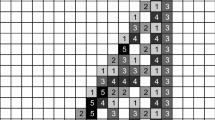Abstract
We study the ability of discrete dynamical systems to transform/ generate randomness in cellular spaces. Thus, we endow the space of bi-infinite sequences by a metric inspired by information distance (defined in the context of Kolmogorov complexity or algorithmic information theory). We prove structural properties of this space (non-separability, completeness, perfectness and infinite topological dimension), which turn out to be useful to understand the transformation of information performed by dynamical systems evolving on it. Finally, we focus on cellular automata and prove a dichotomy theorem: continuous cellular automata are either equivalent to the identity or to a constant one. This means that they cannot produce any amount of randomness.
Access this chapter
Tax calculation will be finalised at checkout
Purchases are for personal use only
Preview
Unable to display preview. Download preview PDF.
Similar content being viewed by others
References
P. Kůrka A. Maass. Stability of subshifts in cellular automata. to appaer in Fondamenta informaticæ, 2000.
S. Amoroso and Y. N. Patt. Decision procedures for surjectivity and injectivity of parallel maps for tesselation structures. J. Comp. Syst. Sci., 6:448–464, 1972.
C. H. Bennet, P. Gács, M. Li, P. M. B. Vitányi, and W. H. Zurek. Information distance. IEEE Trans. Inform. Theory, 44(4):1407–1423, 1998.
F. Blanchard, E. Formenti, and P. Kůrka. Cellular automata in Cantor, Besicovitch and Weyl topological spaces. Complex Systems, 11–2, 1999.
A. A. Brudno. Entropy and complexity of the trajectories of a dynamical system. Trans. Moscow Math. Soc., 2:127–151, 1983.
C. Calude. Information and Randomness. Springer-Verlag, 1994.
C. Calude, P. Hertling, H. Jürgensen, and K. Weihrauch. Randomness on full shift spaces. Chaos, Solitons & Fractals, 1:1–13, 2000.
G. Cattaneo, E. Formenti, G. Manzini, and L. Margara. Ergodicity and regularity for cellular automata over Z m . Theoretical Computer Science, 233(1-2):147–164, 1999.
G. J. Chaitin. On the length of programs for computing finite binary sequences. J. of ACM, 13:547–569, 1966.
J.-C. Dubacq, B. Durand, and E. Formenti. Kolmogorov complexity and cellular automata classification. Theor. Comp. Sci., 259(1-2):271–285, 2001.
B. Durand. The surjectivity problem for 2D cellular automata. Journal of Computer and Systems Science, 49(3):718–725, 1994.
B. Durand. Global properties of cellular automata. In E. Goles and S. Martinez, editors, Cellular Automata and Complex Systems. Kluwer, 1998.
J. Kari. Reversibility and surjectivity problems of cellular automata. Journal of Computer and System Sciences, 48:149–182, 1994.
A. N. Kolmogorov. Three approaches to the definition of the concept “quantity of information”. Problems of information transmission, 1:3–11, 1965.
M. Li and P. Vitányi. An Introduction to Kolmogorov complexity and its applications. Springer-Verlag, second edition, 1997.
B. Martin. Apparent entropy of cellular automata. Complex Systems, 12, 2000.
P. Martin-Löf. The definition of a random sequence. Information & Control, 9:602–619, 1966.
A. Maruoka and M. Kimura. Conditions for injectivity of global maps for tessellation automata. Information & control, 32:158–162, 1976.
A. Maruoka and M. Kimura. Injectivity and surjectivity of parallel maps for cellular automata. Journal of Computer and System Sciences, 18:158–162, 1979.
E. F. Moore. Machine models of self-reproduction. Proc. Symp. Appl. Math., AMS Rep., 14:17–34, 1963.
J. Myhill. The converse of Moore’s Garden of Eden theorem. Proc. Amer. Math. Soc., 14:685–686, 1963.
K. Sutner. De Bruijn graphs and linear cellular automata. Complex Systems, 5:19–30, 1991.
V. A. Uspensky, A. L. Semenov, and A. Kh. Shen. Can individual sequences of zeros and ones be random? Russ. Math. Surveys, 45:121–189, 1990.
V. A. Uspensky and A. Kh. Shen. Relations between varieties of Kolmogorov complexities. Math. Syst. Theory, 29(3):270–291, 1996.
H. S. White. Algorithmic complexity of points in dynamical systems. Ergod. Th. & Dynam. Sys., 13:807–830, 1993.
Author information
Authors and Affiliations
Editor information
Editors and Affiliations
Rights and permissions
Copyright information
© 2001 Springer-Verlag Berlin Heidelberg
About this paper
Cite this paper
Cervelle, J., Durand, B., Formenti, E. (2001). Algorithmic Information Theory and Cellular Automata Dynamics. In: Sgall, J., Pultr, A., Kolman, P. (eds) Mathematical Foundations of Computer Science 2001. MFCS 2001. Lecture Notes in Computer Science, vol 2136. Springer, Berlin, Heidelberg. https://doi.org/10.1007/3-540-44683-4_22
Download citation
DOI: https://doi.org/10.1007/3-540-44683-4_22
Published:
Publisher Name: Springer, Berlin, Heidelberg
Print ISBN: 978-3-540-42496-3
Online ISBN: 978-3-540-44683-5
eBook Packages: Springer Book Archive




